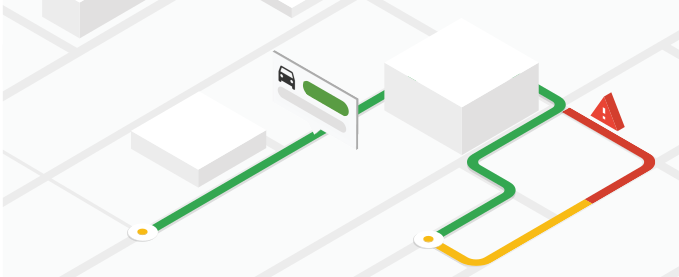
Alasan menggunakan Directions API
Dengan Directions API, Anda bisa mendapatkan rute untuk beberapa moda transportasi, seperti transportasi umum, mengemudi, jalan kaki, atau bersepeda.
Apa yang dapat Anda lakukan dengan Directions API?
Dengan Directions API, Anda dapat menghitung rute antar-lokasi, termasuk detail berikut:
- Rute untuk beberapa moda transportasi, termasuk transportasi umum, mengemudi, berjalan kaki, atau bersepeda.
- Rute multi-bagian menggunakan serangkaian titik jalan.
- Tentukan asal, tujuan, dan titik jalan dalam berbagai cara, termasuk sebagai string teks (misalnya, "Chicago, IL" atau "Darwin, NT, Australia"), ID tempat, atau koordinat lintang/bujur.
Cara kerja Directions API
Directions API menampilkan rute yang paling efisien saat menghitung rute. Produk ini mempertimbangkan elemen perjalanan berikut saat menentukan rute yang paling efisien:
- Waktu tempuh (utama)
- Jarak
- Jumlah putaran
Contoh permintaan berikut menampilkan petunjuk arah mengemudi dari Toronto, Ontario ke Montreal, Quebec dalam format JSON:
https://maps.googleapis.com/maps/api/directions/json ?destination=Montreal &origin=Toronto &key=YOUR_API_KEY
Resource
Tabel berikut merangkum resource yang tersedia melalui Directions API beserta data yang ditampilkan.
| Resource data | Data yang ditampilkan | Format pengembalian |
|---|---|---|
| Directions
Berikan tempat asal dan tujuan dalam bentuk ID tempat, alamat, atau koordinat lintang/bujur. Lihat parameter yang diperlukan untuk mengetahui detailnya. |
Petunjuk arah yang terperinci, yang dibagi menjadi rute, segmen, dan langkah. Lihat Respons petunjuk arah untuk mengetahui detailnya. |
|
Cara menggunakan Directions API
| 1 | Lakukan penyiapan. | Mulai dengan Menyiapkan project Google Cloud dan selesaikan petunjuk penyiapan berikutnya. |
| 2 | Coba demo | Setelah memiliki kunci API dan project cloud, Anda dapat mencoba demo petunjuk tanpa biaya. Lihat Demo Directions API. |
| 3 | Buat permintaan | Lihat contoh permintaan dan pelajari opsi yang tersedia yang dapat Anda berikan, seperti mode perjalanan, titik jalan, dan batasan rute. Lihat Contoh petunjuk arah. |
| 4 | Memahami dasar-dasar respons | Jelajahi respons data untuk mempersiapkan penggunaan data petunjuk arah untuk aplikasi Anda. Lihat Respons petunjuk arah untuk detailnya. |
| 5 | Sertakan data arah ke dalam aplikasi Anda sendiri. | Anda dapat menggunakan data ini untuk menghitung jarak dan waktu perjalanan. |
Library klien yang tersedia
Panggil API ini dalam bahasa pilihan Anda melalui salah satu library klien berikut:
- Klien Java untuk Layanan Google Maps
- Klien Python untuk Layanan Google Maps
- Klien Go untuk Layanan Google Maps
- Klien Node.js untuk Layanan Google Maps
Klien Java, Klien Python, Klien Go, dan Klien Node.js untuk Layanan Google Maps adalah library klien yang didukung komunitas, yang bersifat open source berdasarkan Lisensi Apache 2.0. Download library klien dari GitHub, tempat Anda juga dapat menemukan petunjuk penginstalan dan kode contoh.
Langkah berikutnya
- Mulai menggunakan Directions API: Buka Mulai.
- Mulai membuat permintaan Petunjuk Arah: Buka Dapatkan petunjuk arah.
- Ikuti praktik terbaik: Buka Praktik terbaik layanan web.

